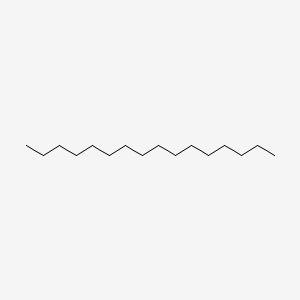| MeSH term | MeSH ID | Detail |
|---|---|---|
| Body Weight | D001835 | 333 associated lipids |
| Coronary Disease | D003327 | 70 associated lipids |
| Encephalomyelitis, Autoimmune, Experimental | D004681 | 26 associated lipids |
| Glomerulonephritis | D005921 | 35 associated lipids |
| Hyperplasia | D006965 | 34 associated lipids |
| Keratosis | D007642 | 9 associated lipids |
| Lupus Erythematosus, Systemic | D008180 | 43 associated lipids |
| Peritonitis | D010538 | 38 associated lipids |
| Serratia Infections | D016868 | 2 associated lipids |
Hexadecane
Hexadecane is a lipid of Fatty Acyls (FA) class. The involved functions are known as Analyte. The related lipids are Fatty Acids and palmitoleic acid.
Cross Reference
Introduction
To understand associated biological information of Hexadecane, we collected biological information of abnormalities, associated pathways, cellular/molecular locations, biological functions, related genes/proteins, lipids and common seen animal/experimental models with organized paragraphs from literatures.
What diseases are associated with Hexadecane?
There are no associated biomedical information in the current reference collection.
Possible diseases from mapped MeSH terms on references
We collected disease MeSH terms mapped to the references associated with Hexadecane
PubChem Associated disorders and diseases
What pathways are associated with Hexadecane
There are no associated biomedical information in the current reference collection.
PubChem Biomolecular Interactions and Pathways
Link to PubChem Biomolecular Interactions and PathwaysWhat cellular locations are associated with Hexadecane?
There are no associated biomedical information in the current reference collection.
What functions are associated with Hexadecane?
Related references are published most in these journals:
| Function | Cross reference | Weighted score | Related literatures |
|---|
What lipids are associated with Hexadecane?
Related references are published most in these journals:
| Lipid concept | Cross reference | Weighted score | Related literatures |
|---|
What genes are associated with Hexadecane?
There are no associated biomedical information in the current reference collection.
What common seen animal models are associated with Hexadecane?
There are no associated biomedical information in the current reference collection.
NCBI Entrez Crosslinks
All references with Hexadecane
Download all related citations| Authors | Title | Published | Journal | PubMed Link |
|---|---|---|---|---|
| Oda M et al. | Molecular species of platelet-activating factor generated by human neutrophils challenged with ionophore A23187. | 1985 | J. Immunol. | pmid:3917470 |
| Somerville CC et al. | Modification of the 14C most-probable-number method for use with nonpolar and volatile substrates. | 1985 | Appl. Environ. Microbiol. | pmid:3922301 |
| Severson DL and Hurley B | Stimulation of a neutral triacylglycerol hydrolase from rat heart by phosphatidylethanolamine and lysophosphatidylethanolamine. | 1986 | Lipids | pmid:3959764 |
| Tierno MA and Brenner RR | [Biochemistry of the life cycle of Triatoma infestans (vinchuca). 1. Lipids and fatty acids composition]. | 1978 | Acta Physiol Lat Am | pmid:400662 |
| Woodard LF and Jasman RL | Stable oil-in-water emulsions: preparation and use as vaccine vehicles for lipophilic adjuvants. | 1985 | Vaccine | pmid:4036272 |
| Gibson WT et al. | The effect and mode of action of zinc pyrithione on cell growth. II. In vivo studies. | 1985 | Food Chem. Toxicol. | pmid:4038672 |
| Medvedeva TN et al. | [Production of extracellular higher fatty acids by yeasts grown on hexadecanoic acid]. | 1985 Jan-Feb | Mikrobiologiia | pmid:4040202 |
| Rozman T et al. | Effect of partial jejunectomy and colectomy on the disposition of hexachlorobenzene in rats treated or not treated with hexadecane. | 1985 | Toxicol. Appl. Pharmacol. | pmid:4049391 |
| Singer ME and Finnerty WR | Fatty aldehyde dehydrogenases in Acinetobacter sp. strain HO1-N: role in hexadecanol metabolism. | 1985 | J. Bacteriol. | pmid:4066609 |
| Delaissé JM and Nyns EJ | Detection of cytochrome P-450 in subcellular fractions of Endomycopsislipolytica grown on n-hexadecane. | 1974 | Arch. Int. Physiol. Biochim. | pmid:4136627 |
